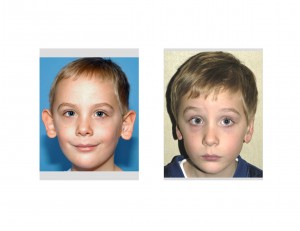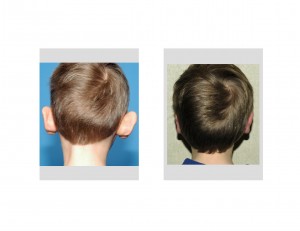Background: Protruding ears are a frequent source of embarrassment and ridicule. Whether it is a young school-age child or an adult, ears that stick out too far can make one very self-conscious. There is an established angle number between the side of the head and the ear. (auriculo-cephalic angle, 20 to 30 degrees) However, how one feels about the position of the ear is more important than any number.
Otoplasty, corrective ear reshaping, can be done at almost any age. In my Indianapolis plastic surgery practice, I have performed otoplasty on patients from age two to seventy-four. Otoplasty is a simple cartilage manipulation of the ear that is not affected by the age of the patient.
Case Study:This is a classic case of pediatric or school-age otoplasty. An eight year-old male was seen with very prominent ears. Often called cupped ears when they are very prominent, the ear angle is close to 90 degrees. The cup description comes from the large concha (bowl or cup) that is responsible for driving the ear away from the side of the head. Interestingly, his mother had her ears done when she was a child and his younger sister also had prominent ears, demonstrating that ear shape and position has a familial influence. In some families, there must be a gene loci for this condition when it affects so many members of the same family.
There has been some debate about the timing of otoplasty surgery. It was historic teaching that otoplasty should not be done until at least age six, when the ear is near fully grown. The concern was that early cartilage manipulation would affect its growth. This has not been borne out by both experimental research and clinical experience. Otoplasties done as early as age two have failed to show any subsequent growth problems. Conversely, there is no upper age limit when it can be done either. The cartilage never becomes too stiff to be folded and bent. Feel the ear in a senior citizen as you will find it is still quite pliable.

This boy’s otoplasty was performed as an office-based procedure under general anesthesia. Through incisions on the back of the ear (postauricular incision), the cartilage was exposed. Some plastic surgeons prefer to take a strip of skin from the back of the ear, others do not. The original methods of otoplasty believed that skin removal was a necessary part of the procedure to ensure setback. That is no longer believed to be true. A combination of horizontal mattress sutures for antihelical fold creation and simple sutures for conchal setback were done. Placing these sutures is a bit of an art form and there is no precise science as to how many sutures should be used. Nor what type of sutures should be used. I prefer braided non-resorbable (mersilene) sutures but slow resorbing sutures can be used as well. The incision is closed with dissolveable sutures.

The effects of otoplasty are immediate and dramatic. They may initially look a little pulled back too far in the beginning but that relaxes into a more natural position in the first few months after surgery.
Case Highlights:
1) Otoplasty can be performed at almost any age. The timing of surgery is based purely on the psychological motivation of the patient or parents in the young child.
2) Ear reshaping in otoplasty is done primarily by either folding the cartilage to create more of an antihelical fold or suturing the conchal cartilage back to the mastoid fascia. Sometimes a wedge of conchal cartilage is removed to break the recoil of the cartilage and prevent some relapse of ear position.
3) Otoplasty is a reliable and proven method of ear repositioning that has few complications with a quick recovery.
Dr. Barry Eppley
Indianapolis, Indiana


